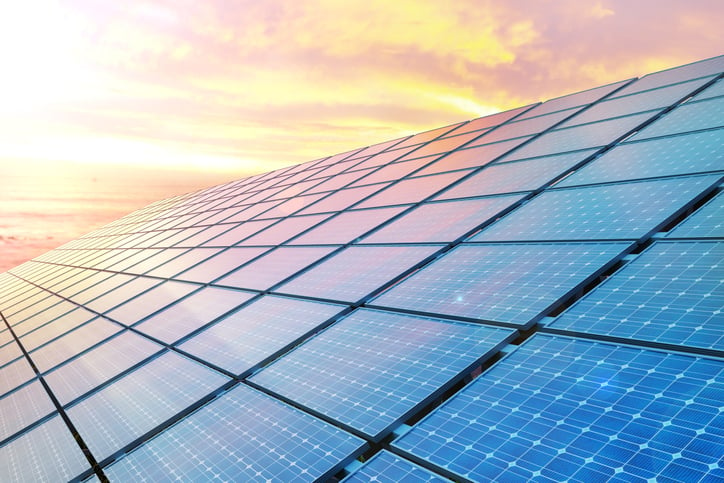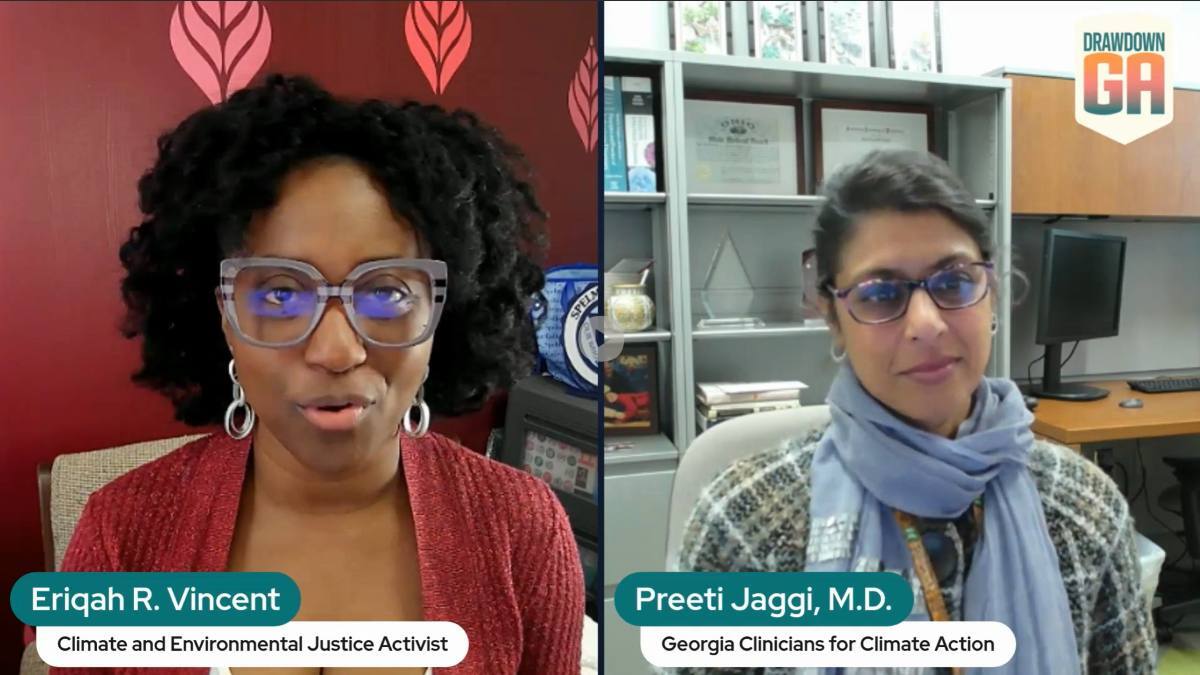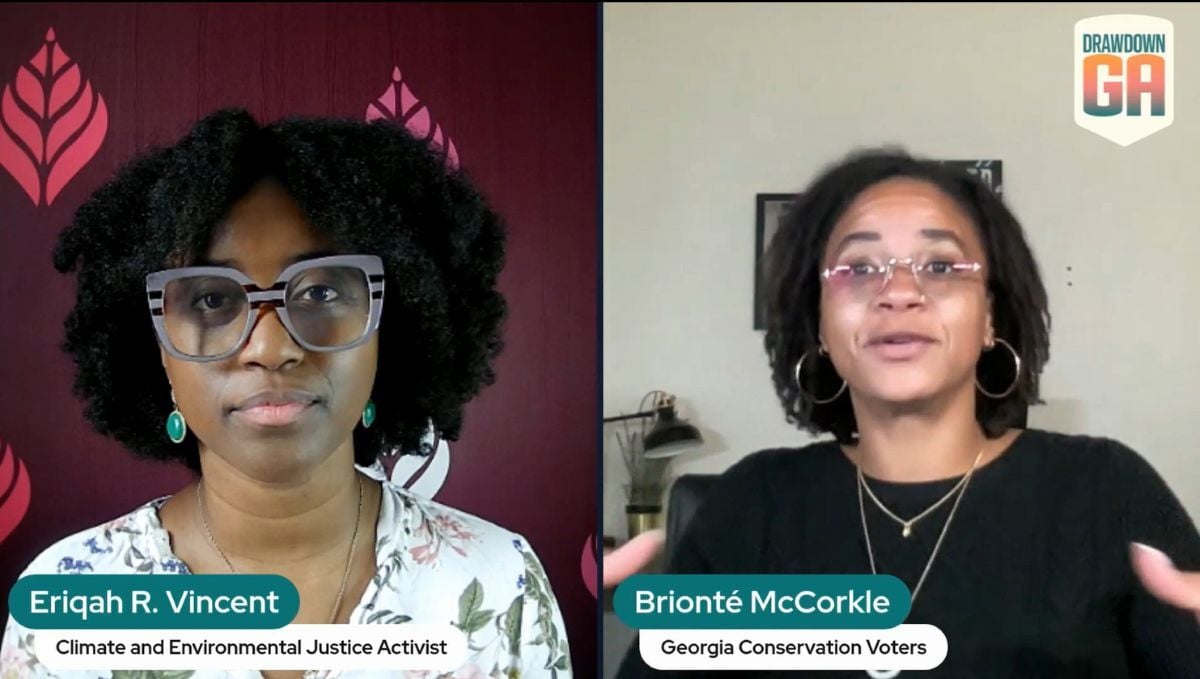Were you aware that the Georgia Power Integrated Resource Planning (IRP) process and the decisions that the Georgia Public Service Commission (PSC) makes affect the pathway for scaling many Drawdown Georgia climate solutions?
The following is a recap of a recent, lively conversation among a panel of experts about what was at stake in the 2022 IRP and subsequent rate case, including how the decisions made will affect the future of climate solutions in our state.
Focus on Georgia’s Energy Future: Climate Solutions That Go Beyond Carbon
Drawdown Georgia hosted a conversation with four experts to unpack the answers to key questions related to Georgia’s energy future:
- Kevin Kelly, policy advisor, Southface Institute
- Jill Kysor, senior attorney and leader of the Solar Initiative at the Southern Environmental Law Center
- Brionte McCorkle, executive director, Georgia Conservation Voters
- Alicia Brown, clean energy program manager, City of Savannah’s Office of Sustainability
Join the conversation by watching the video embedded above, or continue reading to find out how decisions made by the PSC will impact climate solutions in our state, as well as how they’ll affect the communities and individuals who live here.
An Introduction to the Georgia Power IRP
Kevin Kelly set the stage by providing an overview of the IRP and rate case including how these important processes fit together.
By statute, the IRP determines a 20-year plan for Georgia Power, and the process occurs every three years. The most recent IRP ran from January to July 2022. The subsequent rate case then determines how the plan will be paid for. It followed right on the heels of the IRP in July and ended in December.
What is the IRP?
In the simplest terms, the IRP contains the utility's electricity demand and energy forecast for its service territory for at least a 20-year period, and it describes the utility's plan to meet that forecast in an economical and reliable manner.
One way to think about the IRP is to look at the questions the utility is trying to answer in each plan. In 2022, this included questions like:
-
Which power plants will the utility decommission and when?
-
What size and what type of new plants will it build?
-
What agreements does the utility need to enter into for new long-term power purchases?
-
What transmission improvements and expansions are needed to maintain reliable service?
-
What are the benefits of adding renewable energy resources to the system?
-
How would the implementation of energy efficiency and demand side management incentives help lessen the forecasted load and also benefit customers?
>>Learn more about how the IRP process works + its importance for climate solutions in our state.
The Georgia Power IRP, Rate Case, and Renewable Energy
The 2022 IRP addressed several of the 20 Drawdown Georgia climate solutions, particularly large-scale solar.
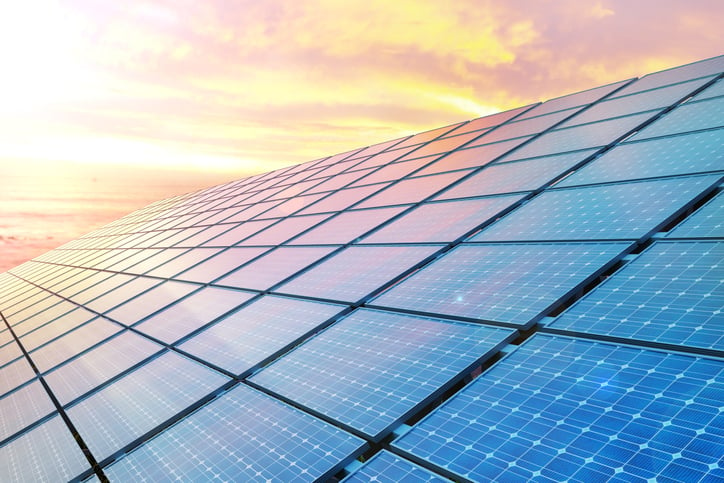
Since 2013, the IRP has included approval of large-scale solar purchasing by Georgia Power. Beginning in 2019, it added the approval of large-solar purchase or subscription programs whereby large customers can buy solar through the utility. These programs are among the single largest drivers of new utility-scale solar development in the state.
While rooftop solar was also discussed in the 2022 IRP, the core issue was ultimately deferred to the rate case. Following the conclusion of the IRP process, proceedings for the 2022 Rate Case began.
The rate case seeks to address four key questions:
-
How much revenue does Georgia Power need to cover the cost of serving customers?
-
What is a reasonable rate of return for the utility to earn on its investment in equipment?
Answering these first two questions helps Georgia Power determine the cost of service. The rate case then determines:
-
How will those costs be allocated to customers?
-
What are good rate designs for the various classes of customers?
A Look at the 2022 Rate Case
A few special issues stood out in the Georgia Power 2022 rate case:
-
The net metering program and the value of energy exported from rooftop solar onto the larger system. How much should the utility pay for those electrons?
-
The expansion of electric vehicle charging infrastructure in the state.
-
The appropriate rate design for charging residential customers, including demand rates appropriate for residential customers, and how to promote the adoption of time-of-use rates.
-
And then finally, data access: can customers get the right level of granularity on their own electricity use data so that they can assess the best rate for themselves, or consider installing solar panels?
Making Your Voice Heard in the IRP Process
Interested stakeholders can get involved in Public Service Commission proceedings in different ways, from following the proceedings online to making public comments to meeting with commissioners directly.
Fuel Cost Recovery Docket
The next opportunity to get involved with the PSC is on the fuel cost recovery docket beginning in late February 2023. The PSC oversees the recovery of the costs that the utility incurs for fuel, including natural gas, coal, and uranium. There are significant costs at play in the upcoming docket due to rising commodity prices.
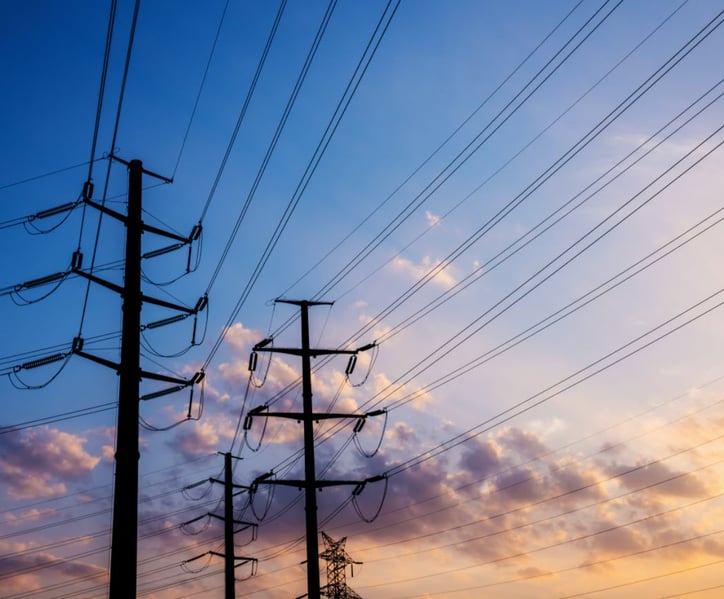
Final Cost Recovery for Vogtle Unit Four
Toward the end of 2023, there will be a proceeding to determine the final cost recovery related to Vogtle Unit Four.
2025 IRP Process
The next IRP will begin in January of 2025.
How the 2022 Georgia Power IRP Affects Climate Solutions
Jill Kysor took a closer look at how the Drawdown Georgia climate solutions fared in the 2022 Public Service Commission proceedings.
Large-Scale Solar in Georgia
According to the Solar Energy Industry Association, Georgia ranks seventh nationally for total solar power installed. The state has more than 4,500 MW of solar already in the ground, which is enough to power about 525,000 homes. In the 2022 IRP proceeding, the PSC approved an additional 2,300 MW of new renewable energy resource capacity, most of which will likely be large-scale solar resources. This new solar capacity will help to replace some of the coal-fired power plants that the PSC agreed to retire in the coming years. The IRP includes plans to retire all remaining coal plants by 2028, with the exception of two units at Plant Bowen, which total about 1,600 MW. The PSC will re-evaluate plans for those units in the next IRP.
When Georgia Power filed its 2022 IRP plan last January, it said that it will have nearly five GW of solar and wind resources online by the end of 2024. Almost all of this capacity has been approved in PSC dockets like the IRP proceeding, which is why they are so important for scaling climate solutions.
Georgia Power also came into the IRP proceeding with a request for new battery storage systems that could be paired with renewables, or that could stand alone. The PSC approved 500 MW of new storage capacity and provisionally approved a 265 MW storage project, representing a significant increase to battery storage in our state.
Rooftop Solar in Georgia
During the proceedings for the IRP and the rate case, many advocates pushed for the expansion of a popular net metering program that Georgia Power had created following the 2019 rate case. The Georgia Power program, which is now at capacity, allowed up to 5,000 rooftop solar customers to get paid about 12 cents per kilowatt hour (KWh) for electrons that are not used on site, but instead, sent onto the grid.
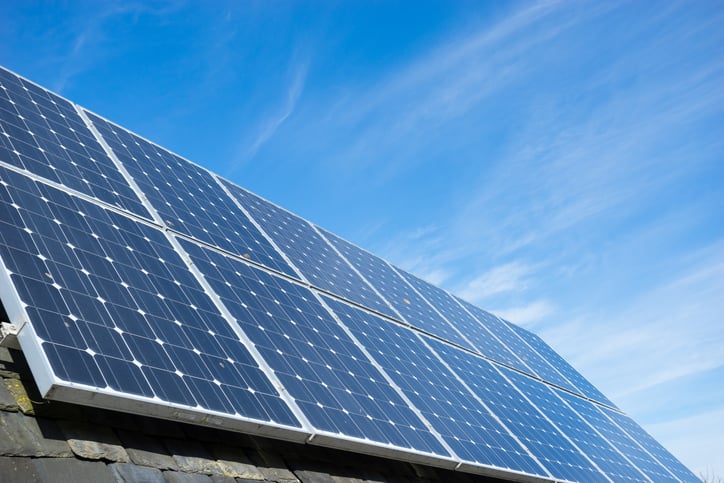
In the IRP proceeding, the PSC deferred this issue to the rate case. The Commission ultimately declined to expand the net metering program and instead set a new compensation rate for all rooftop solar customers. Before the new rate was put in place, Georgia Power was paying about 2.5 cents per KWh for exported solar from rooftop systems that were not in the net-metering program; that rate was increased to about 6.8 cents per KWh.
Kysor explained that time will tell about the impacts of this decision, noting that this modest increase may not be enough to incentivize adoption of rooftop solar in Georgia.
Community Solar Program
Georgia Power customers can pay to opt into a community solar program, but to date those programs have remained under-subscribed with many open shares available. Georgia Power proposed increasing the subscription price by several dollars. The PSC staff testified that the price could be reduced by $5 per share while still allowing Georgia Power to recover its cost, as well as giving customers an opportunity to save money on their bills.
The Commission ultimately chose to lower the subscription price from $25 a month to $24 a month for residential customers.
Energy Efficiency and Demand Response in the IRP
In 2021, Georgia Power achieved about 0.4% savings through its energy efficiency portfolio (a demand side management portfolio) compared to prior year sales, which is well below the national average. As an example, Duke Energy in North Carolina achieves about 1% savings, which is about two and a half times better.
In the 2022 IRP proceeding, clean energy advocates pushed for increased investment in energy efficiency programs and argued that ramping up program investments was not only cost effective, but would also allow Georgia Power to avoid entering into some of the new natural gas capacity contracts that it had proposed. The PSC ultimately voted to ramp up savings above what Georgia Power had proposed, but didn't go quite as far as clean energy advocates pushed. The PSC approved a 15% increase in savings goals; similar to what they had done in 2019.
A Rate Design Win for Georgia Families
There was also a notable rate design win from the 2022 rate case. In response to advocacy from Commission staff and a number of interveners, the PSC undid a decision from the 2019 rate case that had set a complicated demand charge tariff as the default rate for new residential premises. It also rejected Georgia Power's proposal to push new rooftop solar customers onto that same rate.
Those demand charges could hit customers with a big fee based on the single highest usage hour that they have during a month, regardless of whether that high-use hour coincided with a time when the system is stressed or not.

Demand charges, Kysor noted, could be really hard to predict and avoid, as residential customers can't always avoid using multiple appliances at one time. Even though the rate design change is a wonky and technical win, she described the move as a big step forward for Georgia families.
Environmental Justice and the IRP Process
Brionte McCorkle spoke about the importance of stakeholder input into PSC proceedings. This input helps ensure that the policies enacted by governments are designed to deliver fair and equitable outcomes for all involved.
One area where the IRP and rate case directly impact Georgia families is around energy burdens.
Energy burden is the percent of yearly income that households pay for electricity and gas bills. Households nationally, on average, pay about 3% of their income on energy bills. A household that pays more than 6% of their income on energy bills is considered to have a high energy burden, while a household that pays more than 10% is considered to have a severe energy burden.
The map below shows areas in the state with the greatest number of households with severe energy burdens.
Community Voices Heard During the IRP
During the 2019 IRP and rate case processes, McCorkle joined a group of organizers to help people understand the fairly complicated, technical proceedings of the PSC.
The organizers worked with a diverse group of volunteers to comment before the PSC to ask for more renewable energy and more support for energy efficiency programming.
Despite this effort, the PSC approved a significant rate hike and added fees to bills for Georgia Power customers.
Participation in the 2022 Rate Case
Georgia Conservation Voters worked to ensure opportunities for public comment during the 2022 rate case. They also worked to engage the public with media campaign vigils and rallies, and organized people from all over the state to speak during the public comment session.
In the end, the PSC approved a rate increase. McCorkle noted the importance of having electricity to survive and thrive in 2023 and questioned if the amount customers will have to pay to keep the lights on is fair. In the final rate case, the PSC agreed to keep Georgia Power's return on equity for their shareholder profits nearly the same, even though they have one of the highest returns on equity of any utility, at 10.5% versus 9.5%, which is the industry norm.
McCorkle concluded by reminding the audience that commissioners are elected officials - all their contact information is available on the PSC website. McCorkle encouraged attendees to call, email, and text them to share their opinions with the commissioners.
Georgia Coalition of Local Governments at the 2022 IRP
In 2022, for the first time, five local governments--including the City of Savannah, the City of Decatur, the City of Atlanta, the Athens-Clarke County Unified Government and DeKalb County joined together to intervene before the PSC as the Georgia Coalition of Local Governments.
United by their clean energy goals, these five entities had already been working closely together through the Southeastern Sustainability Directors Network for several years. As each government passed clean energy goals and developed plans for achieving them, they realized they wouldn’t be able to achieve those goals without getting involved in processes like the IRP that dictate the future of energy resources in the state.
A Unique Voice Calls for Climate Solutions in the IRP
The Georgia Coalition of Local Governments occupies a unique space in the IRP. They are large customers with interests and clean energy goals of their own, but the coalition also seeks to represent their constituents in the proceedings as well--there hadn't been a voice like that in the process before.
One issue the Coalition was pushing for was the expansion of the popular net metering program. Alicia Brown explained that the City of Savannah is not well-suited to large solar farms, but does have a lot of rooftop space that would be excellent for solar. Expanding the net metering program would’ve helped make rooftop solar investments more attractive and less risky for the city, and could’ve also provided an option for households with high energy burdens to access solar.
The Coalition also pushed hard for improvements to existing energy efficiency programs as a solution to the energy burden crisis.

The coalition also advocated for electric vehicle charging infrastructure, noting that as prices fall for electric vehicles and gas prices remain volatile, EVs can offer savings for low- and moderate-income Georgia families. To achieve that goal, the state needs to make sure that the charging infrastructure is ready to support them.
Growing the Coalition of Local Governments for 2025
Looking ahead, the Georgia Coalition of Local Governments hopes to draw in businesses and community organizations to join their effort. They also hope to add more local governments to their membership, including those in rural areas, for the 2025 IRP.
The 2022 Georgia Power IRP and Its Effect on the State’s Energy Future
The 2022 IRP and rate case will impact greenhouse gas emissions in our state. But, the effort to draw down emissions in Georgia in no way ends with these proceedings. Instead, there will continue to be ways to actively participate, involve others, make your voice heard, and understand how you can make a difference at the PSC.
Don’t miss out on future webinars and events from Drawdown Georgia! Click the button below to subscribe to the Georgia Climate Digest and receive climate news and event updates in your inbox twice per month.


